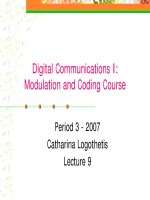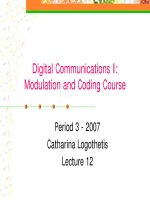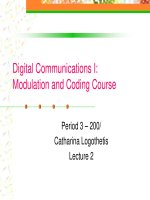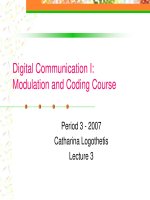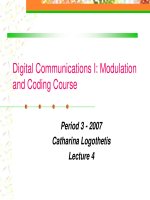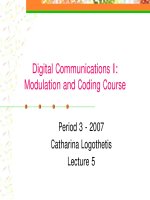Modulation and coding course- lecture 11
Bạn đang xem bản rút gọn của tài liệu. Xem và tải ngay bản đầy đủ của tài liệu tại đây (159.88 KB, 28 trang )
Modulation, Demodulation and
Coding Course
Period 3 - 2007
Catharina Logothetis
Lecture 11
Lecture 11 2
Last time, we talked about:
Another class of linear codes, known as
Convolutional codes.
We studied the structure of the encoder
and different ways for representing it.
Lecture 11 3
Today, we are going to talk about:
What are the state diagram and trellis
representation of the code?
How the decoding is performed for
Convolutional codes?
What is a Maximum likelihood decoder?
What are the soft decisions and hard
decisions?
How does the Viterbi algorithm work?
Lecture 11 4
Block diagram of the DCS
Information
source
Rate 1/n
Conv. encoder
Modulator
Information
sink
Rate 1/n
Conv. decoder
Demodulator
4434421
sequenceInput
21
,...),...,,(
i
mmm=m
4434421
444344421
bits) coded ( rdBranch wo
1
sequence Codeword
321
,...),...,,,(
n
nijiii
i
,...,u,...,uuU
UUUU
=
=
= G(m)U
,...)
ˆ
,...,
ˆ
,
ˆ
(
ˆ
21 i
mmm=m
{
4434421
444344421
dBranch worper outputs
1
dBranch worfor
outputsr Demodulato
sequence received
321
,...),...,,,(
n
nijii
i
i
i
,...,z,...,zzZ
ZZZZ
=
=Z
Channel
Lecture 11 5
State diagram
A finite-state machine only encounters a
finite number of states.
State of a machine: the smallest amount
of information that, together with a
current input to the machine, can predict
the output of the machine.
In a Convolutional encoder, the state is
represented by the content of the
memory.
Hence, there are states.
1
2
−K
Lecture 11 6
State diagram – cont’d
A state diagram is a way to represent
the encoder.
A state diagram contains all the states
and all possible transitions between
them.
Only two transitions initiating from a
state
Only two transitions ending up in a state
Lecture 11 7
State diagram – cont’d
10 01
00
11
outputNext
state
inputCurrent
state
101
010
11
011
100
10
001
110
01
111
000
00
0
S
1
S
2
S
3
S
0
S
2
S
0
S
2
S
1
S
3
S
3
S
1
S
0
S
1
S
2
S
3
S
1/11
1/00
1/01
1/10
0/11
0/00
0/01
0/10
Input
Output
(Branch word)
Lecture 11 8
Trellis – cont’d
Trellis diagram is an extension of the state
diagram that shows the passage of time.
Example of a section of trellis for the rate ½ code
Time
i
t
1+i
t
State
00
0
=S
01
1
=S
10
2
=S
11
3
=S
0/00
1/10
0/11
0/10
0/01
1/11
1/01
1/00
Lecture 11 9
Trellis –cont’d
A trellis diagram for the example code
0/11
0/10
0/01
1/11
1/01
1/00
0/00
0/11
0/10
0/01
1/11
1/01
1/00
0/00
0/11
0/10
0/01
1/11
1/01
1/00
0/00
0/11
0/10
0/01
1/11
1/01
1/00
0/00
0/11
0/10
0/01
1/11
1/01
1/00
0/00
6
t
1
t
2
t
3
t
4
t
5
t
1 0 1 0 0
11 10 00 10 11
Input bits
Output bits
Tail bits
Lecture 11 10
Trellis – cont’d
1/11
0/00
0/10
1/11
1/01
0/00
0/11
0/10
0/01
1/11
1/01
1/00
0/00
0/11
0/10
0/01
0/00
0/11
0/00
6
t
1
t
2
t
3
t
4
t
5
t
1 0 1 0 0
11 10 00 10 11
Input bits
Output bits
Tail bits
Lecture 11 11
Optimum decoding
If the input sequence messages are equally likely, the
optimum decoder which minimizes the probability of
error is the Maximum likelihood decoder.
ML decoder, selects a codeword among all the
possible codewords which maximizes the likelihood
function where is the received
sequence and is one of the possible codewords:
)(
)(m
p
′
U|Z
Z
)(m
′
U
)(max)( if Choose
)(
allover
)()( mmm
pp
(m)
U|ZU|ZU
U
=
′′
¾ML decoding rule:
codewords
to search!!!
L
2


